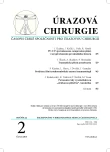PC.C.P. (percutaneous compression plate) in the treatment of proximal femur fractures
Authors:
Ján Kužma; Jan Kočiš; Libor Paša; Radek Veselý
Authors‘ workplace:
Traumatological Hospital Brno, Department of Traumatology, Faculty of Medicine Masaryk University Brno
; Úrazová nemocnice v Brně, Klinika traumatologie Lékařské fakulty Masarykovi Univerzity Brno
Published in:
Úraz chir. 22., 2014, č.2
Článek je věnován k výročí 80. let vzniku Úrazové nemocnice v Brně.
Overview
Objective:
A prospective clinical study which evaluate proximal femur fractures type 31A1, 31A2 and 31B1 according to AO classification treated using the PC.C.P. plate from december 2006 till september 2009 in the Traumatological hospital Brno.
Material and Methods:
In the reporting period, we treated 21 patients with this method (Men 10 : Women 11) The age distribution was from 45 to 93 with an average of 72 years. We evaluated the time of surgery, intraoperative blood loss, signs of bone healing on X-ray and complications.
Results:
Operation time ranged from 45 to 55 min, blood loss was from 40 ml to 200 ml. From the 21 patients we observed in 18 cases bone healing within 3 months. There were no intraoperative complications. Once we have seen the release of the distal neck screw during healing of the fracture. In three cases we have seen the failure of the osteosynthesis, we had to make a conversion to a THA in two cases, one case was complicated with a infection.
Conclusion:
Based on our and previously published results from other hospitals, we recommend this type of osteosynthesis used in indicated cases, especially in elderly patients. Due to less invasiveness of the surgical approach and better stability of the implant we prefer PC.C.P before stabilization through DHS.
Keywords:
Fracture of the proximal femur, percutaneous compression plate, mini-invasive method.
Sources
1. GOTFRIED, Y. PercutaneusCompresion Plating of intertrochanteric Hip Fractures. J Orthop Trauma. 2000, 14, 490–495. ISSN: 0890-5339.
2. GOTFRIED, Y., COHEN, B., ROTEM, A. Biomechanical eluvation of the PC.C.P. system for the hip. J Orthop Trauma. 2002, 16, 644–650. ISSN: 0890-5339.
3. KNOBE, M., DRESCHER, W., HEUSSEN, N. et al. Is helical blade mailing superior to locked minimaxy invasive plating in unstable pertrochanteric fractures? Clin Orthop Relat Res. 2012, 470, 2302–2312. ISSN: 1528-1132.
4. LANGFORD, J., PILLAI, G., UGLIAILORO, AD., YANG, E. Perioperative la-terál trochanteric wall fractures: sliding hip srež versus percutaneous compression plate for intertrochanteric hip fractures. J Orthop Trauma. 2011, 25, 191–195. ISSN: 0890-5339.
5. PEYSER, A., WEIL, Y., LIEBERGALL, M., MOSHEIFF, R. Percutaneous compresion plating for intertrochanteric fractures. Orthop Traumatol. 2005, 17, 158–177. ISSN: 0934-6694.
6. ŠIMEČEK, M., ŠIMEČEK, K., SVOBODA, V., PETERKA, T. PCCP – metoda volby v léčení trochanterických zlomenin na našem pracovišti. Rozhl Chir. 2010, 89, 150–158. ISSN: 0035-9351.
Labels
Surgery Traumatology Trauma surgeryArticle was published in
Trauma Surgery

2014 Issue 2
- Metamizole vs. Tramadol in Postoperative Analgesia
- Metamizole at a Glance and in Practice – Effective Non-Opioid Analgesic for All Ages
- The Importance of Hydration in Wound Healing
- Obstacle Called Vasospasm: Which Solution Is Most Effective in Microsurgery and How to Pharmacologically Assist It?
- Possibilities of Using Metamizole in the Treatment of Acute Primary Headaches
Most read in this issue
- Prevention of venous thromboembolism in traumatology
- TRAUMATIC PULMONARY PSEUDOCYST (TPP)
- High-pressure spray gun injury of a hand - case report
- PC.C.P. (percutaneous compression plate) in the treatment of proximal femur fractures
